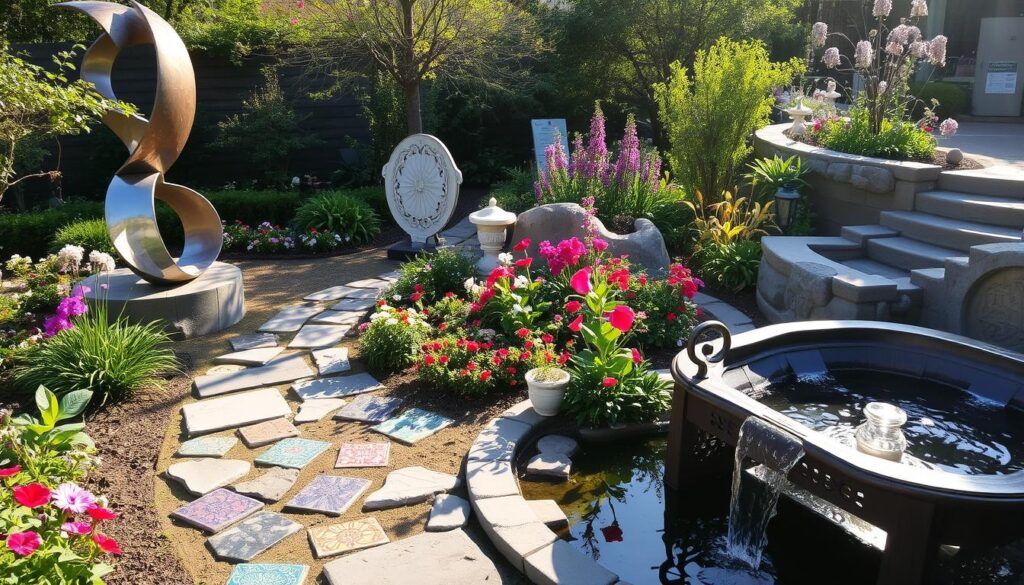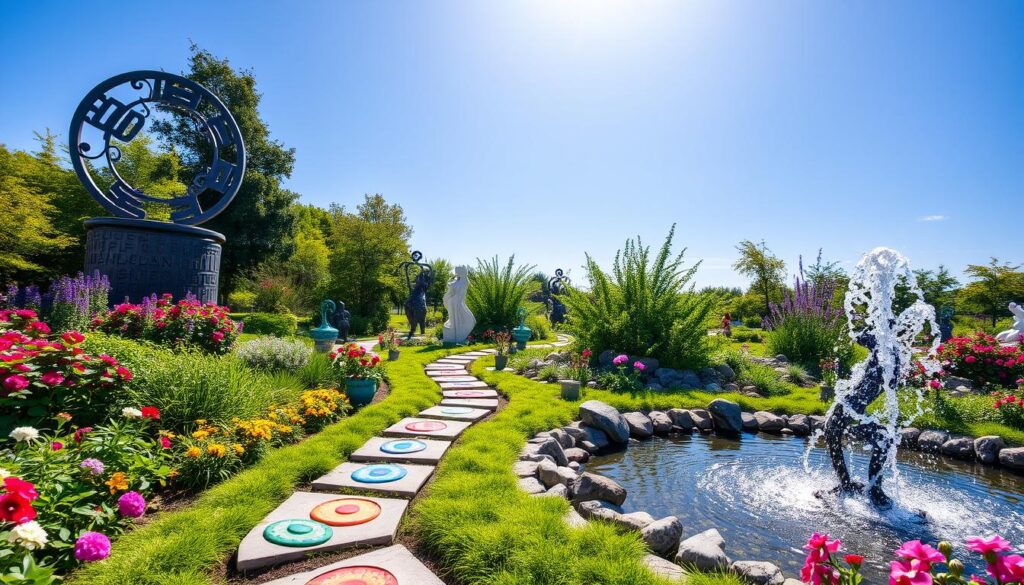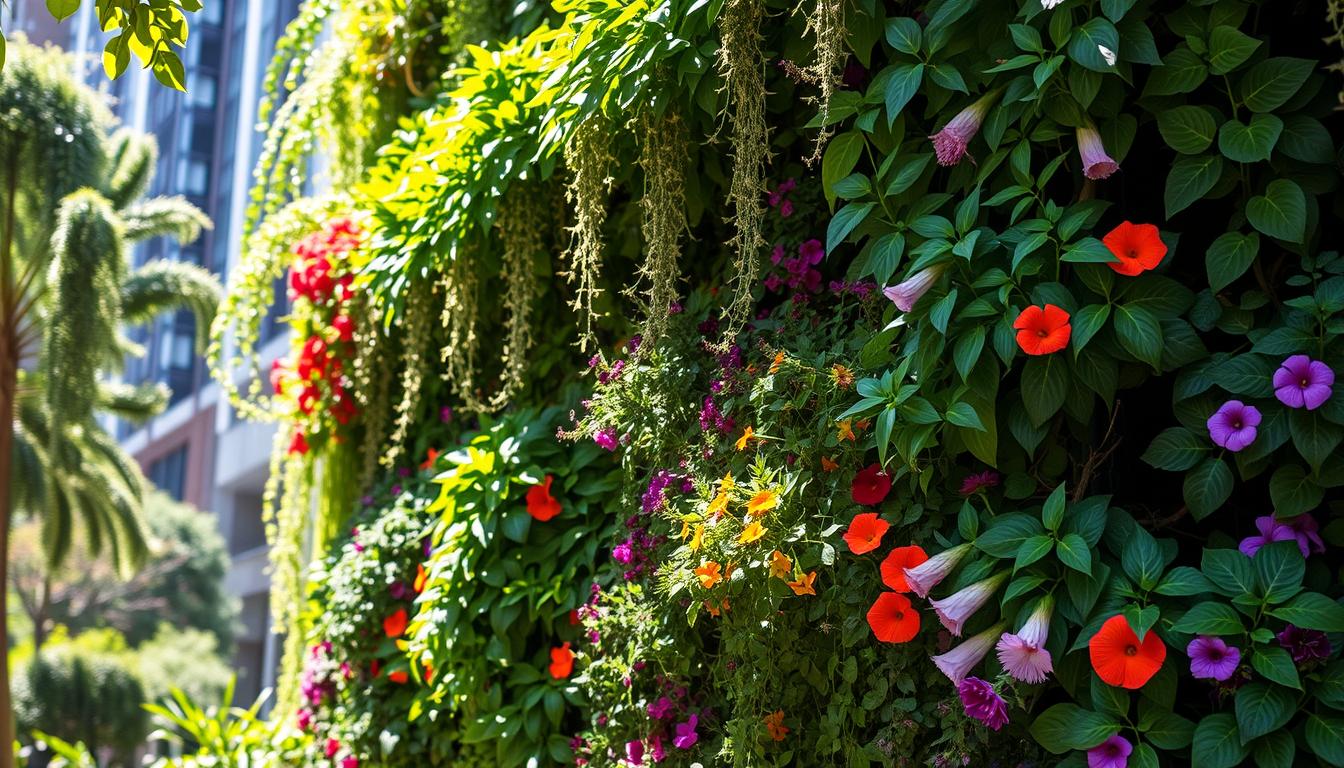Did you know that art installations are now more popular than fountains and sundials in gardens? This change shows a new trend in garden design. By adding art to your outdoor space, you can make your garden stand out. It becomes a personal gallery that shows off your style and adds to the garden’s beauty.
Art installations are not just eye-catching. They also add color, texture, and meaning to your garden. Events like Sculpture in the Garden at the North Carolina Botanical Garden bring people together. They inspire creativity and encourage people to buy art for their gardens.
Most garden art ideas come from homemade projects. This means you can make your garden truly unique. Whether you like whimsical or modern designs, there’s something for everyone. Art and design come together to create gardens that amaze and inspire.

Key Takeaways
- Art installations are growing in popularity over traditional garden features.
- Creating outdoor art can be a personal and creative endeavor.
- Homemade creations represent about 75% of ideas for garden art integration.
- Events like Sculpture in the Garden inspire and facilitate art purchases.
- Art pieces can enhance both visual interest and landscaping aesthetics.
Understanding the Role of Art in Garden Design
Art is key in garden design, adding beauty and mood to the space. It turns a simple garden into a place of wonder and thought. Garden art ideas can make a garden a place of discovery and calm.
Importance of Focal Points
Focal points are crucial in garden design. They make the garden look good and easy to follow. Features like sculptures or water elements catch the eye and lead visitors.
Kinetic sculptures, made from materials like stainless steel, add movement and change. They make the garden feel deeper and more interesting. Whether it’s abstract or natural, these points break up the look and make the garden more beautiful.
Creating Visual Interest with Art
Art makes gardens lively and interesting. Decor like whimsical birdbaths or colorful garden fish adds fun. Even on a tight budget, you can find art that fits your needs.
As more people add art to their gardens, they look for new ways to mix beauty and function. This trend is exciting for garden lovers everywhere.
Historical Context of Art in Gardens
The bond between gardens and art is old, with decoration being key in design. Art in gardens has changed over time, showing cultural and artistic changes. Places like Bedrock Gardens show this history through art made from found objects.
These gardens remind us of art’s power to enhance our surroundings and experiences. They show how art can make a garden more than just a place to be.
How to Incorporate Art Installations into Your Garden Design
Adding art to your garden can make it look and feel amazing. It’s all about choosing art that fits with your garden’s style and theme. This way, the art enhances the garden’s beauty and mood.
Assessing Your Garden’s Style and Theme
First, understand what your garden looks like. Many people get ideas from other gardens or shows. A survey shows 62% of gardeners use their own ideas for adding art.
Think about how the art will match your garden. This helps create a look that feels complete.
Selecting Appropriate Art Pieces
Picking the right art is key. Here are some things to think about:
- Size and Scale: Choose big art to make a statement. Over 64% of gardeners say big art is best.
- Material: Mix materials like concrete, wood, and metals for interest. Eco-friendly materials are also popular.
- Color: Play with colors to make your garden pop. 82% of gardeners like using color tricks.
- Placement: Put art near important spots in your garden. 56% of gardeners place art to draw eyes and create scenes.
- Emotional Impact: Pick art that feels good and connects with you.
Also, don’t overdo it with too many art pieces. 90% of designers say less is more. Well-chosen and placed art can really stand out and add to your garden’s design.
| Factor | Importance | Percentage of Gardeners |
|---|---|---|
| Size | Select larger than perceived | 64% |
| Material | Incorporate mixed eco-friendly materials | Not specified |
| Color | Use color contrast techniques | 82% |
| Placement | Position near focal points | 56% |
| Emotional Impact | Choose art that evokes feelings | Not specified |
Creative Garden Art Ideas to Enhance Your Landscape
Adding art to your garden makes it more beautiful and personal. Unique decorations can spark interesting conversations. Here are some ideas to make your outdoor space more inspiring.
Incorporating Sculptures as Focal Points
Outdoor sculptures can turn your garden into a stunning work of art. You can choose from statues to abstract pieces. These sculptures draw the eye and highlight certain areas.
Try using a galvanized tub with sculptures and plants for a lively mix. Add whimsical touches like plastic dinosaur eggs for fun. Antique items, like a wooden headboard gate, can also add a unique touch.
Utilizing Color and Texture Through Art Installations
Color and texture can change your garden into a lively space. Mosaic projects bring vibrant colors and energy. Using recycled materials adds an eco-friendly touch and unique flair.
Vertical accents, like vintage newels, can add depth and balance to your garden. They complement horizontal elements, making your garden more interesting.
DIY Garden Art Projects for Unique Touches
DIY garden art lets you add your personal touch. You can turn old items into beautiful decorations. For example, an old birdbath can become a succulent garden.
Creating vignettes with plants in new ways can catch the eye. Getting kids involved in these projects can teach them about nature and art.

| Idea | Description |
|---|---|
| Galvanized Tub Arrangement | A combination of sculptures and plants in a galvanized tub for a decorative focal point. |
| Mosaic Projects | Use colorful tiles or broken dishes to create vibrant mosaic designs throughout the garden. |
| Repurposed Items | Transform old items into creative garden art, such as using vintage birdbaths for succulent arrangements. |
| Whimsical Elements | Incorporate fun motifs like plastic dinosaur eggs or playful figures to engage viewers. |
| Vertical Accents | Introduce vertical elements like newels to enhance garden aesthetics and balance horizontal spaces. |
Strategic Placement of Outdoor Art Installations
Placing outdoor art installations wisely can make any garden look better and work better. It guides the eye and connects art with nature. This makes the garden more interesting and fun to explore.
Leading the Eye with Sculpture Placement
Good outdoor sculpture placement means finding the best spots in the garden. Sculptures can be the main attraction, pulling people through the garden. They should be placed in paths or at the end of views to highlight their beauty.
Think about the size and height of the sculptures. They should fit well with the plants around them. This balance makes the garden look even better.
Creating Outdoor Rooms Through Art
Outdoor rooms are great for making the most of your space. Art can help set these areas apart, making them feel cozy and private. A sculpture or fountain can act as a natural wall, adding to the room’s feel.
Using art and architectural features together makes the garden feel more complete. It invites people to stay and enjoy the space.
Balancing Art with Natural Elements
It’s important to mix art with nature carefully. The art should match the garden’s look and feel. Using natural materials or colors helps it blend in.
Think about how the art will look all year. It should stay interesting, even when the plants change with the seasons.

| Placement Strategy | Description | Benefits |
|---|---|---|
| Focal Points | Position sculptures at key vantage points | Enhances visual interest and draws visitors |
| Outdoor Rooms | Define spaces with art and features | Creates distinct areas for relaxation |
| Material Harmony | Choose sculptures that echo nature | Maintains balance between art and environment |
Conclusion
Adding art to your garden makes it more beautiful and meaningful. We’ve looked at how to pick and place art in your garden. The right art can be a highlight, catching the eye and sparking conversations.
Art in your garden creates a beautiful mix of colors, textures, and shapes. You can use different materials like metals or natural elements. This adds excitement and shows off your style. Each piece of art can grow with your garden, showing off the seasons and your growth.
When adding art to your garden, be creative and try new things. Think about the size, where it goes, and how it works with your garden. See your garden as a blank canvas for your art and vision.
FAQ
How can I incorporate art installations into my garden design?
First, think about your garden’s style and theme. Pick art pieces like sculptures that match your garden. This way, your garden looks cohesive and beautiful.
What types of art can enhance my garden’s aesthetics?
Adding sculptures, mirrors, and unique decorations can make your garden stand out. These elements add interest and a personal touch, turning your garden into a gallery.
How do I select the right art pieces for my garden?
Choose art that speaks to you and fits your garden’s theme. Consider size, material, and color. This ensures your art enhances your garden’s look and matches your vision.
What are some creative garden art ideas?
Use sculptures as key points in your garden. Try vibrant colors and textures in your art. You can also do DIY projects like painted stones or repurposed items to show your style.
How should I position art installations in my garden?
Place art to guide the eye and create paths. Think of your garden as outdoor rooms for different activities. Make sure art blends with nature for a balanced look.
Can art installations serve practical purposes in the garden?
Yes, art can be useful too. It can offer shade, seating, or privacy while looking good. Well-placed art makes your garden more inviting and fun to explore.
What elements should I consider when integrating art into my landscaping?
Think about the size, materials, and colors of your art. Make sure they match your garden’s ecosystem. This way, your garden looks artistic and complete.
Are there any historical precedents for integrating art into gardens?
Art and gardens have been together since ancient times. Different styles and trends have evolved. Learning from history helps you place art in a way that feels right.
What are some tips for DIY garden art projects?
Try making painted stones, upcycling items, or creating custom signs. These projects add a personal touch and encourage creativity in your garden.
Source Links
- Art and Sculpture in the Garden
- Incorporating Art and Sculpture in Your Garden Design – Redcliffe Landscape Gardeners
- How Art Fits Into Gardens: Learn About Adding Art In The Garden
- Art In the Garden
- The Role of a Garden Designer
- Art with a Purpose – Garden Design
- How to Add Garden Art & Decor To Your Landscape
- Enhancing Outdoor Spaces: The Art of Modern Garden Design
- Landscape Sculpture Design | Garden Art Placement
- Garden Art Anyone Can Create
- 15 Creative Garden Idea Inspirations to Transform Your Outdoor Space | Yardzen
- How to Design a Serene and Immersive Garden Oasis – Fine Gardening
- Maximizing Garden Aesthetics: Strategic Fountain Placement
- Caring for outdoor sculptures | Berkley One
- How Can You Incorporate Garden Art In Your Landscape?
- The Art of Garden Design: Combining Functionality with Aesthetics
- The Art of the Open Air Living Room Garden – Whole Gardens




